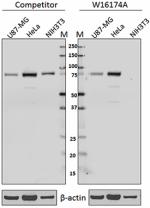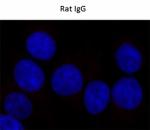- Clone
- W16174A (See other available formats)
- Regulatory Status
- RUO
- Other Names
- Tudor domain-containing protein 3
- Isotype
- Rat IgG2a, κ
- Ave. Rating
- Submit a Review
- Product Citations
- publications

-

Total cell lysate (15 µg protein) from U87-MG, HeLa and NIH3T3 cells were resolved by electrophoresis (4-12% Bis-Tris gel), transferred to nitrocellulose, and probed with 1:250 (2 µg/mL) diluted purified anti-TDRD3 antibody (clone W16174A) or competitor’s antibody used at manufactures recommended concentration (upper). Proteins were visualized by chemiluminescence detection using 1:3000 diluted HRP rat-IgG secondary antibody conjugated to HRP (clone Poly4054) for clone W16174A or 1:3000 diluted donkey anti-rabbit IgG Antibody conjugated to HRP (clone Poly4054) for competitor’s antibody (upper). 1:2000 dilution of Direct-Blot™ HRP anti-β-actin antibody (clone 2F1-1) was used as a loading control (lower). Lane M: MW ladder. -

HeLa cells were fixed with 4% paraformaldehyde (PFA) for 15 minutes, permeabilized with 0.5% Triton X-100 for 3 minutes, and blocked with 5% FBS for 60 minutes. Then the cells were intracellularly stained with anti-TDRD3 (clone W16174A) overnight at 4 degree followed by Alexa Fluor® 594 (red) conjugated goat anti-rat IgG (clone Poly4054) incubation for one hour at room temperature. Nuclei were counterstained with DAPI (blue). The image was captured with a 60X objective. -

HeLa cells were fixed with 4% paraformaldehyde (PFA) for 15 minutes, permeabilized with 0.5% Triton X-100 for 3 minutes, and blocked with 5% FBS for 60 minutes. Then the cells were intracellularly stained with 1:250 (2 µg/mL) rat IgG2b, κ isotype control (clone RTK4530) overnight at 4 degree followed by Alexa Fluor® 594 (red) conjugated goat anti-rat IgG (clone Poly4054) incubation for one hour at room temperature. Nuclei were counterstained with DAPI (blue). The image was captured with a 60X objective.
| Cat # | Size | Price | Quantity Check Availability | Save | ||
|---|---|---|---|---|---|---|
| 601201 | 25 µg | $101 | ||||
| 601202 | 100 µg | $253 | ||||
Tudor Domain Containing 3 (TDRD3) is a protein which specially recognizes di-methylarginine containing proteins. As an effector molecular, it binds to histone methylarginine H3R17me2a and H4R3me2a marked by coactivator-associated arginine methyltransferase (CARM1/PRMT4). In addition, TDRD3 recognizes the Arg1810 me2a modification in the CTD of RNA polymerase II, therefore is associated with transcriptional activation. Recent study suggests other roles other than effector in the nucleus. In cytoplasm, TDRD3 interacts with ubiquitin-specific protease 9 X-linked (USP9X) in cytoplasmic stress granules and is suggested that TDRD3 might regulate USP9X de-ubiqutinase activity. Knockdown of TDRD3 in breast cancer cells sensitizes chemotherapeutic drug-induced apoptosis.
Product DetailsProduct Details
- Verified Reactivity
- Human
- Antibody Type
- Monoclonal
- Host Species
- Rat
- Immunogen
- Partial human TDRD3 (402-651 a.a.) recombinant protein expressed in E. coli.
- Formulation
- Phosphate-buffered solution, pH 7.2, containing 0.09% sodium azide.
- Preparation
- The antibody was purified by affinity chromatography.
- Concentration
- 0.5 mg/ml
- Storage & Handling
- The antibody solution should be stored undiluted between 2°C and 8°C.
- Application
-
WB - Quality tested
ICC - Verified - Recommended Usage
-
Each lot of this antibody is quality control tested by Western blotting. For Western blotting, the suggested use of this reagent is 0.2 - 2.0 µg per ml (1:250 - 1:2500 dilution). For immunocytochemistry, the recommended usage is 0.5 - 2.0 µg per ml (1:250 - 1:1000 dilution). It is recommended that the reagent be titrated for optimal performance for each application.
- Application Notes
-
This antibody does not cross-react with mouse (in-house tested).
- RRID
-
AB_2715902 (BioLegend Cat. No. 601201)
AB_2715903 (BioLegend Cat. No. 601202)
Antigen Details
- Structure
- 651 amino acids with a predicted molecular weight of 73 kD. Contains a C-terminal Tudor domain responsible for recognizing symmetrically dimethylated arginine.
- Distribution
-
Cytoplasm, nucleus.
- Function
- TDRD3 recognizes di-methylarginine containing proteins and functions as a transcriptional activator.
- Interaction
- TDRD3 interacts with FMR1, FXR1, FXR2, EWSR1, FUS, SERBP1, EEF1A1, DDX3, POLR2A, SNRPB, and SNRPN.
- Biology Area
- Cell Biology, Transcription Factors
- Molecular Family
- Nuclear Markers
- Antigen References
-
1. Goto-Ito S, et al. 2017. Sci Rep. 7:42123.
2. Narayanan N, et al. 2017. Cell Discov. 3:16048.
3. Sikorsky T, et al. 2012. Nucleic Acids Res. 40:11748.
4. Yang Y, et al. 2010. Mol Cell. 40:1016.
5. Linder B, et al. 2008. Hum Mol Genet. 17:3236.
6. Goulet I, et al. 2008. Hum Mol Genet. 17:3055. - Gene ID
- 81550 View all products for this Gene ID
- UniProt
- View information about TDRD3 on UniProt.org
Related Pages & Pathways
Pages
Other Formats
View All TDRD3 Reagents Request Custom Conjugation| Description | Clone | Applications |
|---|---|---|
| Purified anti-TDRD3 | W16174A | WB,ICC |
Compare Data Across All Formats
This data display is provided for general comparisons between formats.
Your actual data may vary due to variations in samples, target cells, instruments and their settings, staining conditions, and other factors.
If you need assistance with selecting the best format contact our expert technical support team.
 Login/Register
Login/Register 










Follow Us